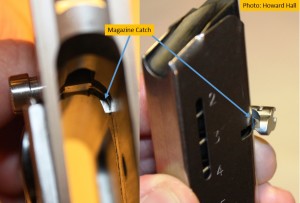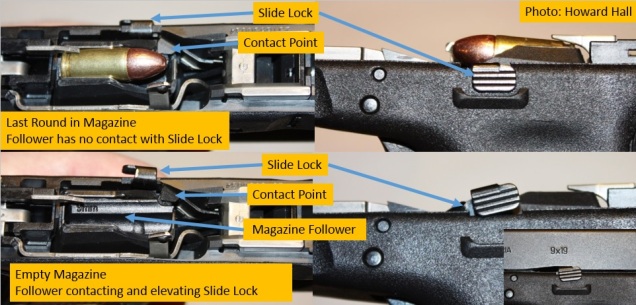 Whether on the range or via e-mail, I receive a lot of questions regarding pistol malfunctions. These questions go beyond discussing the skills required to clear malfunctions. They are geared more toward understanding “what” makes their pistol malfunction and what can be done to prevent the malfunction, rather than just relying on corrective actions alone. There is a lot of material to cover in regard to diagnosing pistol malfunctions, so I’ll break the topic into a three-article series. In general, there are three main types of malfunctions: (1) failure to feed; (2) failure to fire; and (3) failure to extract/eject. This first article: “Diagnosing Pistol Malfunction – Part I” will provide an in-depth discussion on failure to feed.
Whether on the range or via e-mail, I receive a lot of questions regarding pistol malfunctions. These questions go beyond discussing the skills required to clear malfunctions. They are geared more toward understanding “what” makes their pistol malfunction and what can be done to prevent the malfunction, rather than just relying on corrective actions alone. There is a lot of material to cover in regard to diagnosing pistol malfunctions, so I’ll break the topic into a three-article series. In general, there are three main types of malfunctions: (1) failure to feed; (2) failure to fire; and (3) failure to extract/eject. This first article: “Diagnosing Pistol Malfunction – Part I” will provide an in-depth discussion on failure to feed.
Cycle of Operations
I chose failure to feed since it is arguably the start of the cycle of operations. Internal Ballistics Part I listed detailed descriptions on each of the elements in the cycle of operation, which are: Feeding, Chambering, Locking, Firing, Unlocking, Extracting, Ejecting, and Cocking.
To be more specific on the definition of failure to feed, we will look closely at a semi-automatic pistol’s operation from the point of full slide recoil through the forward motion that strips the cartridge from the magazine, chambers the round, and locks into battery. This discussion will cover the majority of possible malfunctions or interruptions of the first three elements in the cycle of operations.
Slide Lock Malfunctions
Since we are starting this discussion from the point of full rearward slide movement, the first thing that can prevent the slide’s movement forward is an unanticipated slide lock engagement. Although it is easy to clear this malfunction, it is very frustrating and can cost precious seconds in a live engagement or competition.
When things are working properly, a small tab on the top left side of the magazine follower engages the portion of the slide lock protruding into the interior of the frame. As the last round is stripped from the magazine, the follower moves to the highest position in the magazine. Once that last round is fired and ejected, the follower pushes the slide lock protrusion and slide lock body up and into a small cut-out in the slide, thus locking it to the rear. Click the image below for a larger view.
When things aren’t working properly, the slide lock moves “up,” engages the slide while there are still cartridges in the magazine. Most pistols have an internal spring connected to the slide stop assembly which prevents inadvertent upward movement. 1911 style pistols have an external spring and plunger that provide friction against the face of the slide stop to prevent inadvertent engagement. If the malfunction is within the pistol, it may be due to a damaged or weak slide stop or plunger spring (1911). Otherwise, this can occur due to a magazine that is damaged or out of specification.
Most shooters don’t want to hear this, but the primary cause of premature slide-lock is shooter induced. I’ve heard shooters swear up and down that they are not the cause, only to find out that one of their thumbs “gently grazed” the slide stop and moved it upward during recoil.
If you are having this malfunction: (1) make sure it is not shooter induced; (2) check the magazines for proper contact with the slide stop; and (3) check the slide stop spring or the plunger spring in 1911s.
Cartridge Not Stripped From Magazine
This occurs when a round is fired, the case was extracted and ejected properly, but the next round is not stripped from the magazine leaving the slide to move forward and lock on an empty chamber. I’ve seen this a lot and it has happened to me on occasion during USPSA shooting.
Magazine improperly seated – Many of us have been there… we receive the command to “make ready,” so we insert a magazine, pull the slide to the rear and chamber a round, conduct a chamber check to ensure that a cartridge was chambered, apply the safety, holster, and wait for the signal to start firing. We hear the “beep,” unholster, index the first target, press the trigger, and send the first round down range. However, our second trigger press is met with a “click,” followed by any number of expletives. While we verified that the first cartridge was chambered, without ensuring that the magazine was fully seated, the slide simply “skipped over” the next cartridge instead of stripping it from the magazine and chambering it. A simple “tap” on the bottom of the magazine followed by racking the slide sets everything straight… most of the time.
 In some cases, however, the problem is not shooter error, but is caused by the mechanical interaction within the pistol. There is a small cut-out in the magazine that contacts the internal surface of the magazine catch and locks the magazine in place within the frame. If the magazine is damaged in the vicinity of the cut-out, the magazine catch itself is damaged, or if there is dirt/debris blocking the magazine well, the magazine may not fully seat, which will cause the slide to “skip over” and completely miss the next cartridge in the magazine.
In some cases, however, the problem is not shooter error, but is caused by the mechanical interaction within the pistol. There is a small cut-out in the magazine that contacts the internal surface of the magazine catch and locks the magazine in place within the frame. If the magazine is damaged in the vicinity of the cut-out, the magazine catch itself is damaged, or if there is dirt/debris blocking the magazine well, the magazine may not fully seat, which will cause the slide to “skip over” and completely miss the next cartridge in the magazine.
Chamber Feed Failure – Nose Down
This occurs when the tip of the cartridge impacts the feed ramp on the frame or barrel at a downward angle, fails to feed into the chamber, and halts the motion of the slide… thus jamming the pistol.
There are a number of potential causes for this type of malfunction which include the magazine, the extractor, the feed ramp, and the cartridge itself. Let’s start with a discussion on the magazines. Read More >>
Posted by Howard Hall
